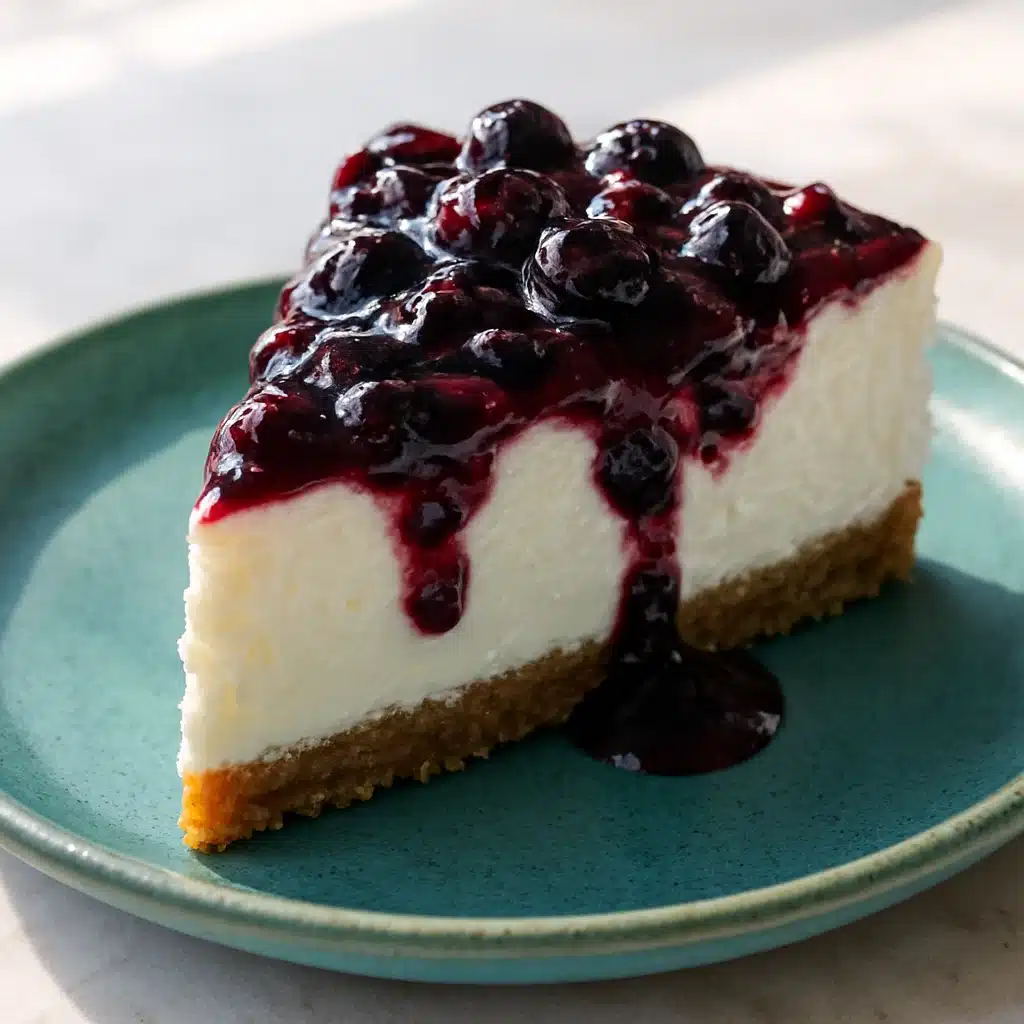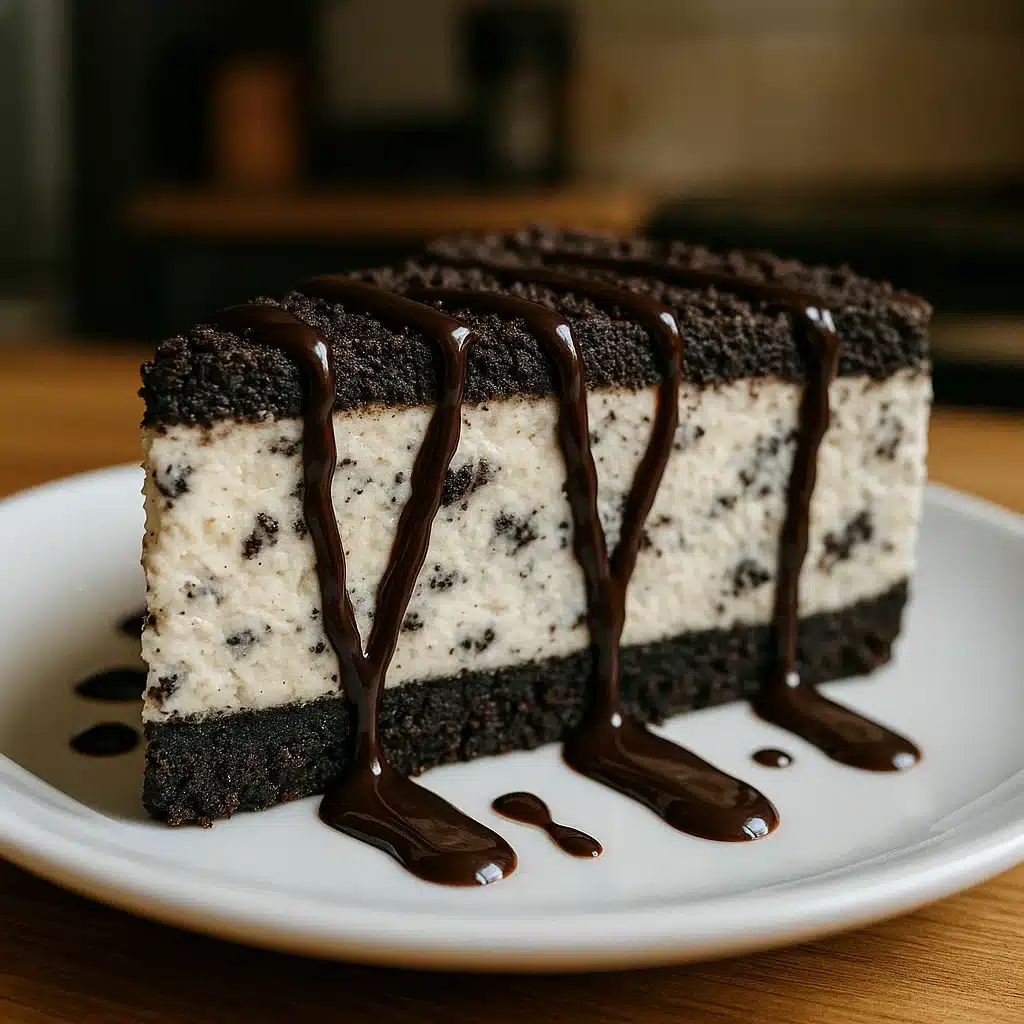Looking for a way to indulge without the guilt? This Greek Yogurt Cheesecake recipe is here to change the dessert game. By swapping out heavy ingredients for protein-rich Greek yogurt, this version delivers all the creaminess of traditional cheesecake—without the sugar overload or extra fat. Whether you’re gluten-free, watching calories, or just love a silky smooth texture, this healthier cheesecake is a must-bake.

Table of Contents
Table of Contents
What Is Greek Yogurt Cheesecake?
Why Greek yogurt is a game-changer for cheesecake
Classic cheesecake is rich, dense, and indulgent—but also loaded with saturated fat and refined sugars. That’s where Greek yogurt comes in. By replacing part (or all) of the sour cream or heavy cream, Greek yogurt transforms the filling into a lighter, protein-packed version that still holds its creamy integrity.
Here’s what makes Greek yogurt a star in cheesecake:
- Higher protein: Makes it more filling and satisfying
- Lower fat: Reduces calories without compromising texture
- Tart flavor: Balances the sweetness naturally
- Creamy consistency: Bakes beautifully into a smooth custard-like base
Greek yogurt also helps create that classic “cheesecake tang,” while keeping the structure firm but soft enough to melt in your mouth.
Health benefits of using Greek yogurt in desserts
When you replace traditional heavy cream or sour cream with Greek yogurt, you’re not just cutting calories—you’re upgrading your dessert with real nutritional value.
| Benefit | Why It Matters |
|---|---|
| High in protein | Keeps you fuller longer |
| Calcium-rich | Supports bone health |
| Probiotics | Helps digestion and gut health |
| Fewer empty calories | Less sugar and saturated fat |
| Low glycemic index | Helps avoid sugar spikes |
If you’re looking for a dessert that fits into a balanced, clean-eating lifestyle, this recipe is for you. And don’t worry—you won’t miss the richness. This cheesecake is still indulgent, creamy, and totally satisfying.
Love creamy desserts? This Greek yogurt chia pudding with chocolate might be your new favorite.
Healthier Ingredient Swaps That Don’t Sacrifice Flavor
Greek yogurt vs sour cream or heavy cream
One of the easiest and most impactful changes you can make in a traditional cheesecake recipe is swapping out sour cream or heavy cream for plain Greek yogurt. The result? A creamy texture that rivals the original—without all the saturated fat and empty calories.
Let’s compare the three:
| Ingredient | Calories (per 100g) | Fat (g) | Protein (g) | Texture & Flavor |
|---|---|---|---|---|
| Heavy cream | 340 | 36 | 2 | Rich, dense |
| Sour cream | 193 | 19 | 3 | Tangy, smooth |
| Greek yogurt | 59–120 | 0–5 | 10 | Creamy, slightly tart |
Greek yogurt is a nutrient-dense alternative that retains creaminess and gives the cheesecake a light tangy edge that complements the sweetness. For best results, go with 2% or full-fat yogurt—it holds up well during baking and prevents the filling from turning watery.
Reducing sugar without losing taste
The beauty of this recipe is that you can easily cut down the sugar without sacrificing flavor. In fact, Greek yogurt’s natural tang allows you to use less sugar because it balances sweetness and adds complexity.
Here’s how to adjust sweeteners:
- Use 2/3 cup granulated sugar for balanced sweetness
- Go down to 1/2 cup if using vanilla yogurt or serving with sweet toppings
- Swap with coconut sugar or maple syrup for a more natural touch
- Try monk fruit or stevia blends for a low-carb, low-glycemic option
Pro Tip: Taste your filling before adding eggs. This lets you tweak the sweetness based on your preference or your yogurt’s tartness.
| Sweetener | Glycemic Index | Flavor | Best For |
|---|---|---|---|
| Granulated sugar | High | Classic sweet | Traditional taste |
| Coconut sugar | Medium | Mild caramel | Unrefined sugar substitute |
| Maple syrup | Medium-high | Rich, earthy | Natural sweetening |
| Stevia blend | Low | Varies | Low-carb/keto versions |
Ingredients Breakdown + Tips for the Perfect Texture
Choosing the right yogurt, cream cheese, and crust
Let’s break down what makes this Greek yogurt cheesecake taste so amazing—and still healthier than the traditional kind. Picking the right ingredients is the key to getting that silky-smooth, rich texture without going overboard on fat or sugar.
Print
Greek Yogurt Cheesecake
- Prep Time: 1 hour
- Cook Time: 1 hour
- Total Time: 2 hours
- Yield: 16 slices 1x
- Category: Dessert
Description
This Greek Yogurt Cheesecake delivers the classic rich, velvety texture you love—with fewer calories and more protein. Made with a graham cracker crust and topped with a naturally sweet berry compote, it’s a lighter twist on a timeless dessert. Perfect for make-ahead occasions and easily adaptable for gluten-free or low-sugar diets.
Ingredients
For the crust:
1 ½ cups graham cracker crumbs (gluten-free if needed)
5 tablespoons unsalted butter, melted
1 tablespoon granulated sugar
For the filling:
2 blocks (16 oz) cream cheese (full-fat or reduced-fat), room temperature
1¾ cups plain Greek yogurt (2% preferred), room temperature
⅔ cup granulated sugar
3 large eggs, room temperature
1 teaspoon vanilla extract
2 teaspoons lemon juice
For the berry compote:
1½ cups mixed berries (blueberries, strawberries, raspberries)
2 tablespoons lemon juice
½ tablespoon chia seeds (optional, for thickening)
Instructions
Preheat oven to 350ºF. Wrap the bottom and sides of a 9-inch springform pan with heavy-duty foil to prepare for a water bath.
Make the crust: Combine graham cracker crumbs, melted butter, and sugar. Press evenly into the bottom of the springform pan. Bake for 8 minutes, then let cool. Lower oven temp to 325ºF.
Make the filling: In a large mixing bowl, beat cream cheese until smooth. Add sugar, Greek yogurt, vanilla, and lemon juice; beat again until smooth. Add eggs one at a time, mixing on low speed just until incorporated.
Assemble & bake: Pour filling over the crust. Place the springform pan inside a larger roasting pan. Add hot water to the roasting pan until it reaches halfway up the cheesecake pan. Bake at 325ºF for 45–55 minutes, or until the center slightly jiggles.
Cool gradually: Turn off the oven, crack the door, and let cheesecake cool for 1 hour. Remove from the oven and chill in the fridge for at least 8 hours or overnight.
Make compote: Simmer berries and lemon juice in a saucepan for 10–15 minutes. Stir in chia seeds if using. Cool and spoon over cheesecake before serving.
Notes
Yogurt: Use 2% or full-fat for best results. Non-fat may cause a chalky texture.
Sugar: You can reduce to ½ cup if using vanilla yogurt or topping with a sweet compote.
Room temp ingredients: Crucial to avoid a lumpy batter and ensure even baking.
Water bath: Helps prevent cracking—don’t skip it!
Berry topping: Add just before serving for a fresh, vibrant finish.
Nutrition
- Calories: 187 kcal
- Sugar: 12g
- Sodium: 201mg
- Fat: 12g
- Saturated Fat: 7g
- Carbohydrates: 15g
- Fiber: 1g
- Protein: 6g
Greek Yogurt
Go with plain, unsweetened 2% Greek yogurt for the best balance between creaminess and fat. Full-fat works well too, especially if you want a denser filling. Avoid non-fat yogurt if possible—it can lead to a chalky or watery texture after baking.
Recommended Brands:
- Tillamook (less tart, super creamy)
- Fage (classic texture)
- Chobani (widely available and reliable)
Cream Cheese
You can use full-fat or ⅓-less-fat cream cheese—just be sure it’s room temperature to prevent clumping.
| Type | Texture | Flavor | Best Use |
|---|---|---|---|
| Full-fat | Creamy | Rich | Classic cheesecake flavor |
| Neufchâtel | Soft | Mild | Lighter option |
Crust
The classic graham cracker crust still works beautifully—and yes, it can be gluten-free. Use gluten-free graham crackers or almond flour and butter for a grain-free base.
Crust Ingredients:
- 1 ½ cups graham cracker crumbs
- 5 tablespoons melted butter
- 1 tablespoon sugar (optional)
Mix, press, bake briefly, and cool before adding the filling.
Why room temperature ingredients matter
If there’s one rule you can’t skip when making cheesecake, it’s this: all your ingredients need to be at room temperature. Cold ingredients won’t blend well, which causes lumps in your batter and affects the final texture.
Here’s what should be room temp:
- Greek yogurt
- Cream cheese
- Eggs
Cold cream cheese, especially, is notorious for clumping. Give everything at least 30–60 minutes on the counter before mixing.
| Ingredient | Ideal Temperature | Reason |
|---|---|---|
| Greek Yogurt | ~68°F (20°C) | Prevents separation |
| Cream Cheese | ~68°F (20°C) | Smooth texture, no lumps |
| Eggs | Room temp | Incorporates evenly |

For a fruity, beautiful option, explore our layered Greek yogurt and berry dessert recipes.
Step-by-Step – How to Make Greek Yogurt Cheesecake
Making a Greek yogurt cheesecake from scratch might sound like a challenge, but once you follow this easy step-by-step process, you’ll see just how approachable (and rewarding) it really is.

Preparing the crust and water bath
Start by prepping your baking environment. Cheesecake needs gentle, even heat to bake without cracking—and that’s where the water bath comes in.
Step 1: Prep the pan
- Use a 9-inch springform pan
- Wrap the outside tightly with 2–3 layers of heavy-duty foil to prevent leaks
Step 2: Make the crust
- Combine 1 ½ cups graham cracker crumbs, 5 tbsp melted butter, and 1 tbsp sugar
- Press evenly into the bottom of the springform pan using the back of a measuring cup
- Bake at 350ºF for 8 minutes, then cool and reduce oven to 325ºF
This crust is lightly sweet, buttery, and strong enough to hold the creamy filling.
Step 3: Prepare the water bath
- Place the wrapped springform pan inside a larger roasting pan
- Boil water and pour about 1 inch into the outer pan (not inside the cheesecake pan!)
- The steam keeps the oven moist and helps prevent cracks
Making the creamy filling the right way
This is where the magic happens. Use room temperature ingredients for a smooth, lump-free batter.
Step 4: Beat the cream cheese
- Using a hand or stand mixer with paddle attachment, beat 2 blocks (16 oz) of cream cheese for 2–3 minutes until smooth
Step 5: Add Greek yogurt and flavorings
- Mix in 1¾ cups plain Greek yogurt, 2/3 cup sugar, 1 tsp vanilla, and 2 tsp lemon juice
- Blend until completely smooth—scrape down the sides as needed
Step 6: Add eggs
- Crack in 3 eggs, one at a time, mixing on low to medium speed
- Mix just until each egg is incorporated—don’t overmix
Pro Tip: Overmixing creates too much air in the batter, which can lead to rising and cracking during baking.
Step 7: Pour and bake
- Pour the batter over the cooled crust
- Place the roasting pan (with water) into the oven
- Bake at 325ºF for 45–55 minutes—the center should jiggle slightly like jello
Once done, turn off the oven, crack the door, and let the cheesecake rest for 1 hour. Then chill it in the fridge for at least 8 hours (overnight is best).
When you’re craving something cold and healthy, these frozen Greek yogurt snacks hit the spot.
Serving & Pairing Suggestions
Once your Greek yogurt cheesecake is chilled, topped, and ready to serve, it’s time to bring it to the table in style. Whether you’re planning a dinner party, brunch, or a casual weekend dessert, the way you serve and pair your cheesecake can make it even more memorable.
When and how to serve Greek yogurt cheesecake
This cheesecake is incredibly versatile—it works well as a light finish to a rich meal or as a mid-afternoon treat with a cup of coffee.
Serving Tips:
- Always serve cold, straight from the fridge for best texture
- Use a sharp, thin-bladed knife warmed under hot water for clean slices
- Wipe the blade between cuts to keep edges smooth and beautiful
Perfect for:
- Brunch or tea parties
- Summer BBQs with fresh berries on top
- Make-ahead holiday desserts
- Health-conscious dinner guests
For presentation, consider adding:
- A sprig of fresh mint
- A light dusting of powdered sugar (optional, for visual appeal)
- A drizzle of dark chocolate or lemon glaze
Beverage and dessert pairings
Pairing your cheesecake with the right beverage enhances the flavor experience. Here are some crowd-pleasing combos that work with Greek yogurt’s tangy creaminess.
Beverage Pairings:
| Beverage | Why It Works |
|---|---|
| Black coffee | Cuts through richness |
| Sparkling water | Refreshing contrast |
| Green tea | Herbal balance for fruity toppings |
| Champagne | Ideal for celebrations |
| Riesling wine | Sweet, complements berry compote |
Dessert Pairings:
- Fresh fruit salad for a refreshing side
- Mini chocolate truffles for contrast
- Lemon bars to mirror citrusy cheesecake notes
Conclusion
If you’re craving a dessert that’s rich, creamy, and completely satisfying—but without the heaviness—Greek yogurt cheesecake is your go-to recipe. By using protein-packed Greek yogurt, cutting down on sugar, and choosing wholesome ingredients, you can enjoy every bite knowing it fits right into a balanced lifestyle.
Whether you top it with fresh berries, a silky compote, or keep it classic with a graham cracker crust, this lightened-up cheesecake proves you don’t have to give up dessert to eat well. It’s make-ahead friendly, perfect for gatherings, and easy to adapt for gluten-free or low-sugar needs.
You’ll love what we’ve gathered! Discover 10 creative and healthy ways to make desserts with Greek yogurt in this special article : 10 Greek Yogurt Dessert Recipes You’ll Love.
FAQs
Is Greek yogurt cheesecake healthier?
Yes, Greek yogurt cheesecake is a healthier alternative to traditional versions. By replacing sour cream or heavy cream with Greek yogurt, you’re cutting down on saturated fat and adding more protein. It’s perfect for those looking for a lighter dessert without sacrificing flavor or texture.
Can I use non-fat Greek yogurt in cheesecake?
You can use non-fat Greek yogurt, but the texture may be slightly more chalky or watery compared to 2% or full-fat versions. For best results, stick with 2% Greek yogurt which balances creaminess and lightness beautifully.
What’s the best way to sweeten a Greek yogurt cheesecake?
The most common method is using 2/3 cup of granulated sugar, but you can also sweeten it with maple syrup, coconut sugar, or low-calorie sweeteners like monk fruit. Always taste the batter before baking to adjust sweetness to your liking.
How do I keep cheesecake from cracking?
The secret lies in a proper water bath, low baking temperature (325ºF), and a slow cooling process. Don’t overbake, and let the cheesecake cool gradually in the oven before transferring it to the fridge. These steps help maintain a smooth top with no cracks.
Can I make it gluten-free?
Absolutely. Use gluten-free graham crackers or make a crust with almond flour and butter. The filling is naturally gluten-free, so you only need to adjust the crust.
How long should Greek yogurt cheesecake chill before serving?
Let it chill in the fridge for at least 8 hours, or ideally overnight. This gives the cheesecake time to set fully and enhances the flavor and texture.
👉 Join our Facebook community for daily healthy dessert inspiration, tips, and quick video recipes — Follow us on Facebook
👉 Follow us on Pinterest to save and share our top-rated yogurt dessert boards — packed with no-bake treats, frozen creations, and healthy sweets you’ll want to try all year long — Find us on Pinterest



